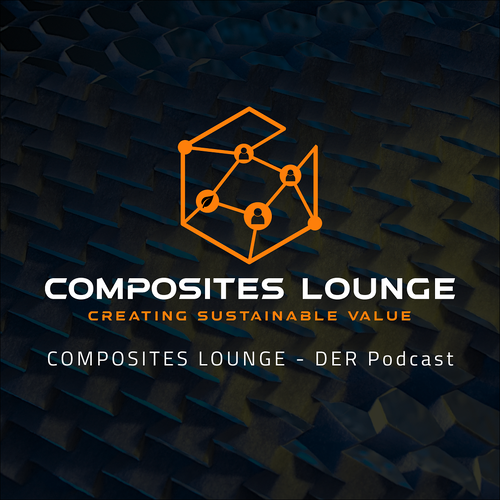#95 Cutting textiles and other substrates: Interview with Sergio Gori, CEO of FK Group during JEC Forum Italy (English)
21.08.2023 14 min Staffel 5 Episode 52
Zusammenfassung & Show Notes
Ever wondered how any composite reinforcement can be safely cut?
During my recent visit to JEC Groups Italy forum, I met Sergio Gori, CEO of FKgroup and took the opportunity to speak with him about feeding materials and cutting same in a safely manner.
What do I mean by that? Safe?
Anyone who is in the textile industry knows, textiles tend to fray when cut. Fraying is annoying, because it destroys the processability in later production steps. Take for instance carbon fabrics that require solid edges for an RTM process.
Secondly, some reinforcement fibres are hell of difficult to cut. Take para-aramid for instance. These fabrics are designed to be overly strong and tightly woven, because they display ballistic properties. Often used in bullet-proof vests, but also firefighting and other personal protection equipment (the meta-aramid variant). Aramids are difficult to cut, but Sergio managed a work around.
Finally, health and safety. Cutting fibres releases fibre dust. Fibrous dust can be as small as a few microns and being airborne reach through the upper respiratory the deeper levels of the lung of workers dealing with this dust.
Therefore it is essential to keep dust levels low. In fact there are several national workplace regulations concerning fiber dust, but even though no airborne harmful respiratory fibres are the aim, Sergio believes in a few years from now (2023) cutting textiles manually will be banned anyway.
Therefore watch our interview till the end. It is explained what is necessary to be able to cut fibreglass, carbon, aramids, hybrids, core, prepreg and multiple layers safely through machines.
In order to keep your workplace clean and protect your factory workers from airborne fibres, do this:
- Check regularly airborne fibre concentration
- Provide dust masks and PPE to workers
- Install and maintain air-suction to the floor (not the ceiling!)
- Never use airpressure for cleaning equipment (releases fibre dust)
- Educate workers to protect themselves and provide black/white change rooms
- Invest in automatic cutting and handling in closed cabins with slight vacuum
Thank you for the nice chat in Bologna, Sergio and Stefano Ratti
PS: Composites Lounge, JEC FORUM DACH is around the corner. Save-the-date: It will be in Salzburg from 25-26 October 2023. Let me know, if you have something that contributes to health&safety, sustainability and innovation.
#Composites360OnTour
During my recent visit to JEC Groups Italy forum, I met Sergio Gori, CEO of FKgroup and took the opportunity to speak with him about feeding materials and cutting same in a safely manner.
What do I mean by that? Safe?
Anyone who is in the textile industry knows, textiles tend to fray when cut. Fraying is annoying, because it destroys the processability in later production steps. Take for instance carbon fabrics that require solid edges for an RTM process.
Secondly, some reinforcement fibres are hell of difficult to cut. Take para-aramid for instance. These fabrics are designed to be overly strong and tightly woven, because they display ballistic properties. Often used in bullet-proof vests, but also firefighting and other personal protection equipment (the meta-aramid variant). Aramids are difficult to cut, but Sergio managed a work around.
Finally, health and safety. Cutting fibres releases fibre dust. Fibrous dust can be as small as a few microns and being airborne reach through the upper respiratory the deeper levels of the lung of workers dealing with this dust.
Therefore it is essential to keep dust levels low. In fact there are several national workplace regulations concerning fiber dust, but even though no airborne harmful respiratory fibres are the aim, Sergio believes in a few years from now (2023) cutting textiles manually will be banned anyway.
Therefore watch our interview till the end. It is explained what is necessary to be able to cut fibreglass, carbon, aramids, hybrids, core, prepreg and multiple layers safely through machines.
In order to keep your workplace clean and protect your factory workers from airborne fibres, do this:
- Check regularly airborne fibre concentration
- Provide dust masks and PPE to workers
- Install and maintain air-suction to the floor (not the ceiling!)
- Never use airpressure for cleaning equipment (releases fibre dust)
- Educate workers to protect themselves and provide black/white change rooms
- Invest in automatic cutting and handling in closed cabins with slight vacuum
Thank you for the nice chat in Bologna, Sergio and Stefano Ratti
PS: Composites Lounge, JEC FORUM DACH is around the corner. Save-the-date: It will be in Salzburg from 25-26 October 2023. Let me know, if you have something that contributes to health&safety, sustainability and innovation.
#Composites360OnTour
